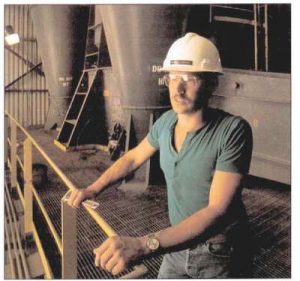Florida Crushed Stone’s F Brooksville, Fla., cement plant was established in 1985 as a way of profiting from waste limestone tailings produced by a nearby mining op-eration also owned by the company. The dry process cement plant now produces 600,000 st/y, selling the product to ready mix operators, contractors, the state of Florida and the state of Georgia.
The plant was built by Polysius, a West German firm. The Cyclopol cement separator plus its four surrounding cyclones were installed with an added feature recommended by Polysius to extend working life – basaltic ceramic tile, annealed to withstand the abrasion produced by cement clinker and cement dust.
Florida Crushed Stone produces approximately 145 st/h of Type I and Type II portland cement through the Polysius separator, more than its rated capacity of 120 st/h, to take advantage of the lower electricity costs that prevail during off-peak hours. This allows the separator to be shut down during high electricity demand periods and still handle the total plant requirement.
According to Florida Crushed Stone process engineer Andy Hollingshead, the separator generally runs from late morning to early evening, and again from late night until down. The need to run during these hours was reduced somewhat in May 1988, when a 125-megawatt power plant came on line. The Cyclopol separator is part of a closed circuit process, and actually handles 390 st/h. Because not all of the ground clinker is fine enough to be separated off as product to the four surrounding cyclones, the oversized material is recirculated through the grinding system.
When the system has achieved a “steady state”, usually about 1 ½ hours after start up, 250 st/h are recycling from the separator back to the grinding process. So during “steady state” operations, the separator receives 390 st/h from the feed mill, 140-145 st ending as a finished product, plus the 250 st/h that are recycled to be fed through again. Clinker for the grinding mills is produced in a 14-ft, 5-in. diameter Polysius Gepoltype kiln, 229 ft, 8 in. in length.
Abrasion potential
Abrasion could clearly be a problem in this type of separator. The ground clinker to be separated inters the air separator via an air slide and is distributed evenly throughout the separator by a rotating disk. Abrasion occurs from the impact of the ground clinker being tossed against the sides of the separator by the centrifugal action of the rotary disk distributor. Abrasion also occurs as the hard clinker slides against the sides of the separator.
Separation is also achieved with a regulated air stream which enters the separator from below at 4,000-8,000 cu ft/min, depending on the capacity required. The air stream is further controlled by guide vanes, which act on the air flow to separate the fines from the coarser materials to be recycled. The four cyclones which receive the finished product are subject to abrasion as the finer particles are removed from the airstream by centrifugal forces which cause the abrasive cement to stay against the sided as it spirals down to the outlet. Because the separator and cyclones are handling abrasive materials, protection against abrasion is vital.
Separator/cyclone linings
The company which supplied the linings, Kalenborn Abresist Corp., lined the separator and cyclones at its Urbana, Ind., facility before Polysius installed them at Florida Crushed Stone. At Kalenborn Abresist Corp., 2,300 sq ft of custom-designed hexagonal tile were installed using cement mortar. The lining material installed, called ABRESIST, is an annealed basaltic ceramic which becomes smoother and more polished with use. The tiles are 1 ¼ in. thick, and periodic inspection of the cyclones and separator have shown no appreciable wear. Expected lifetime of the lining material is 20 years, based on field experience in other cement plants.
